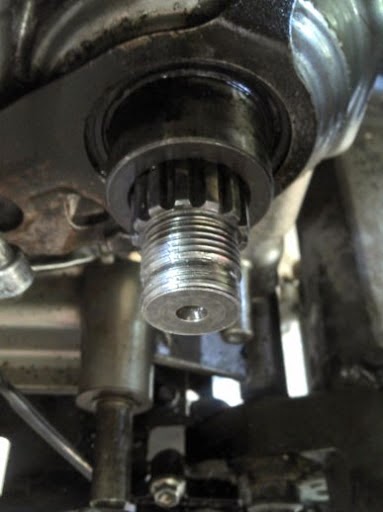So here is the extracts from the original VSRI topic www.vstrom.info
I recently needed to change the chain kit on my DL650. What should have been a routine task turned into a big problem. The retaining nut for the front sprocket was proving difficult to remove. It took a substantial amount of force using a breaker bar to release the nut. The resulting damage to the threads on the output shaft was not good. The thought of how the damage occurred was either when the bike shop changed the last sprocket, they crossed threaded the nut with an airgun, or that whilst I was undoing it, the nut tangs broke or maybe there was too much gunk on the threads? We'll never know.
 |
| The nut was finally removed revealing the horror of the stripped threads |
 |
| The stripped nut |
The idea was to use a split die, view this video for an explanation YouTube. However, a standard die off the shelf wouldn't work as I wanted to cut the thread in reverse, by starting it on the good thread that was left neaerest the engine, and turn it anti-clockwise out, cutting a new thread as it went. So I spoke to a local tool maker who we use at work. He knows his stuff, and is a keen biker too. Recently he restored a Bantam and a 1952 Bonnie T100.
 |
| My drawing shows the amount of 'good' thread remaining on the shaft |
You can also see that I got him to machine a recess at one end. This is so that it will fit over the splined shaft and make sure that all the cutting edges of the die start on the good threads.
The die has been reversed too, as we are cutting counter-clockwise.
.jpg) |
| The reversed thread split die |
I bought a 38mm socket to turn the die. My toolmaker machined some grub screws to ensure that the two half's of the die are pressed together when inside the socket.
It was impossible to show in a picture, but this is the socket with the die inside. And I am just nipping up the grub screws. It was in fact extremely tricky to get the die & shims in the socket.
Its one of those things that seems simple when you go over it in your head - a different beast altogether in reality! Perseverance and patience was the key here.
It was extremely nerve-racking when cutting the thread. I would cut a bit, stop and dismantle the whole socket and check and make sure I wasn't damaging the good thread.
I did this so many times, and to be honest I was cacking it! I knew that if I fooked this up, it was strip-down engine time.
I used lots of lube, and finally the die was through. This is the finished thread. Now it might not look that great, but I am very happy with the result.
The very badly damaged threads were never going to return, there just wasn't enough metal left to cut on to. But it did ensure the good threads were cleaned up and that the thread would
start nicely and a nut would go on without cross-threading. Here I had purchased an M20 std hex full nut to try out first before using the locking nut which comes with locking compund already.
 |
| 38mm Socket with machined grub screw points to hold the die together |
Its one of those things that seems simple when you go over it in your head - a different beast altogether in reality! Perseverance and patience was the key here.
 |
| The assembled socket containing the split die |
I did this so many times, and to be honest I was cacking it! I knew that if I fooked this up, it was strip-down engine time.
I used lots of lube, and finally the die was through. This is the finished thread. Now it might not look that great, but I am very happy with the result.
 |
| The new thread |
start nicely and a nut would go on without cross-threading. Here I had purchased an M20 std hex full nut to try out first before using the locking nut which comes with locking compund already.
 |
| Testing the new thread with a standard nut |
But with the amount of good thread (ended up with about 1 thread protruding the nut), the lock nut, locking compund, good torque and a washer, I'd be surprised if this sucker moves!
 |
| Finished. The new sprocket fitted |
Thanks to everyone who offered suggestions. They were all very warmly welcomed.
Update May 2019. This is the first time I have changed the chain and sprockets since doing the above repair. That was some 8 years and 25,000 miles ago. And I am pleased to say that I had no problems at all. I just made sure the shaft and nut were doused in WD40 to lubricate and to keep it clean when undoing the 'tang' nut.
ReplyDeleteNew set installed. Here's to another 25,000 miles of trouble-free Stromming!!!
....Sadly I lent the tool to a fellow Vstrommer in the Netherlands last year who had the same unfortunate situation. Not to blame him, but on returning my bespoke tool, it was lost in the mail and was never seen again.
ReplyDelete